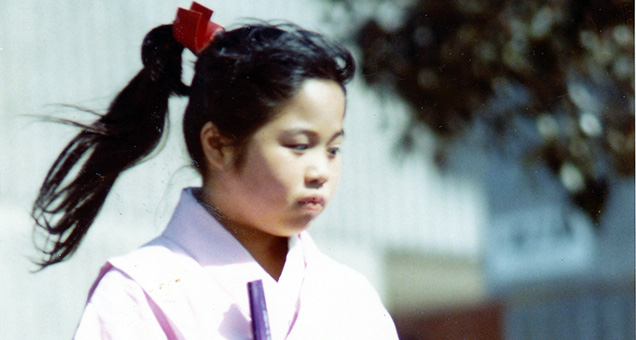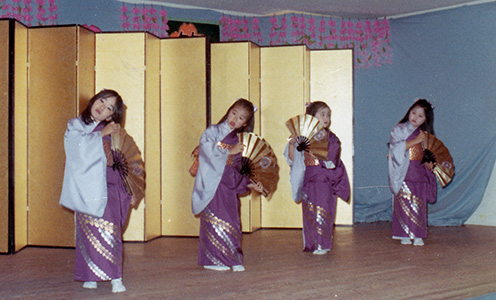 (short hair fused with long hairpiece, during the one year we were asked to wear our hair long)
(short hair fused with long hairpiece, during the one year we were asked to wear our hair long)
I once had long, thick, straight and beautiful hair until I was 9, when both my grandmother and mother decided that I would survive a humid Japanese summer better with a short cut. We went to the beauty salon, where my hair was tied back and chopped off with one swift stroke of shears. “Okay, finished!,” the salonist said (in Japanese, of course), and I was left with an unimaginative haircut with crooked ends. My hair went on to become a chaotic mess of fly away curls, as the cut seemed to bring out the natural wave that I inherited from my Japanese family. The hair that was cut, however, went on to become the basis for a wig that would be used for Japanese dancing.
My mother used to fasten that piece of hair onto my head whenever I had to dance in the Cherry Blossom Festival with the Rokushige Fujima Dance Troupe. She poked my head with black bobby pins, most with their soft edges missing, then swirl the ponytail around my head until it became a bun. There would be more bobby pins to keep it in place, but I always had to slap the hairpiece onto my head – as if it were secured by super glue. The crisp April San Francisco wind would always manage to curl its fingers around the hairpiece, moving it off-center while rebellious strands would loosen from the pins. By the time our troupe would reach the heart of Japantown, my hair looked as it had been jacked up by helium, and I would be the lone dancer with a beehive hairdo.
This memory, along with remembrances of plastic pink and white cherry blossom stems that we would sometimes have to hold, were the Cherry Blossom Festival experience for me. The festival began when I was a toddler, and I became an early participant by the time I was five. Back then, when the parade route began at Morning Star, the Japanese American Catholic grammar schooI, I would scurry behind the older dance troupe members while waving my arms, stomping my little feet and smiling at the admiring crowd of people who would line the parade route waving their plastic cherry blossom branches. The route was easy and short, winding down about 6 blocks away at the heart of the newly constructed Japantown.
As the community became larger and the parade became popular, there were other attractions added to the Cherry Blossom festival. My friend Patricia participated in the tea ceremony exhibitions, the Miharas were always showing off their origami skills and my sister took part in the judo demonstration out on the Peace Plaza stage. I remember the friends who played koto and shamisen in the smaller rooms of the Miyako Hotel as the sound of beautiful strings would fill the hallway.
Every year until I was 15, I remember standing near the stage in my kimono and makeup, watching as eyes were concentrated on my exotic appearance. As I would take the stage and look out into the sea of curious faces, among there were the friends who had stood in front stage along with my sister, who was made faces while I danced. The wind would always blow, and I would spend half the dance pushing away the dangling hair ornaments that kept waving in front of my face. My kimono sleeves would billow, and whatever props I held were subject to the force of the wind. Sometimes I would have to grip the fan tight to make sure it did not fly away, while other times I remember setting down my paper umbrella, watching it spin around in circles until someone would run on stage to hold it down for me.
 (Japanese dance during a festival exhibition)
(Japanese dance during a festival exhibition)
My mind would try to concentrate on the intricacies of moves that were centered around simple neck moves, expressive hand gestures and lithe, careful movement to tell a story. However my mind would wander off to thoughts of Chris Speier, Willie McCovey and the San Francisco Giants. The festival events took place during the month of April, and I had a one-track mind once baseball season began.
The high point of the festival was at the end, when the Cherry Blossom parade would draw dance troupes, marching bands, local dignitaries and a slew of police horses that liked to defecate along the parade route. Sure enough, it was the trail of horse manure that would intimidate most of the dancers, as we had to look straight ahead to make sure to keep in step with other dancers while maintaining a clean, straight line. This led to dancers unintentionally stomping into a pile of horse crap, and the ensuing drama of tears, screams and dirty kimonos.
The mikoshi, a giant palanquin that requires the strength of many drunk men clad only fundoshi, was always at the end of the parade. They would zig zag down Pine street yelling “Wasshoi” in unison as the mikoshi, heavy on their backs, bobbed up and down to the rhythm of the whistle and taiko drums. Parade goers watched, cheered and joined in the festivities until the mikoshi came charging into the Peace Plaza, finally coming to rest at the eternal pools.
During one particular parade, a mikoshi carrier — my mother’s friend who was drunk on sake and covered with sweat — walked up to and gave her a long, heavy tongue kiss . His familiarity and her response made me back away, and images of strange men – my mother’s friends – that came and went through my life quietly began to flash before me. I had been scuttled into small apartments, made to wait on a couch while my mother occupied herself in another room with a man. I would tag along as an unwanted intruder to these affairs, and this man’s kiss brought back a flood memories that I had tried so hard to suppress. I remember one of these men dining with the family, and I watched as my father concentrated on his bowl of sukiyaki, never looking up or asking to be included into a conversation that was in a language unfamiliar to him.
At some point during that kiss, my mother pushed the man away and grabbed me by my hand as we walked away. I never saw him again, and that was last time I would cross paths with any of my mother’s strange male friends. This moment would dull and dominate my memories of the festival until a few years ago, when I began exchanged cherry blossom festivals for trips to Japan and the art of cherry blossom gazing.
One visit north to Aizu Wakamatsu in Fukushima prefecture a year after the tsunami of 2011 brought me to areas where rows of cherry blossom trees would rain down its pink petals. I stood among a crowd of people clustered beneath the trees, all of us looking skyward as we let the gentle petals brush our faces, fall into our hair and touch our hand with light, fleeting caresses. Even among so much tragedy, the Japanese knew to move on and leave the bad things behind. I could only do the same.
Happy Cherry Blossom Festival, San Francisco!
(c)2014 Slow Suburban Death. All rights reserved
Be First to Comment